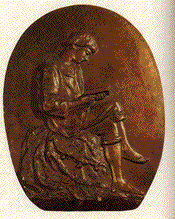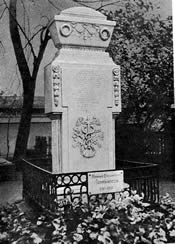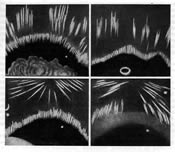|
 Lomonosov as a child
Lomonosov as a child
 Lomonosov's chemistry lab
Lomonosov's chemistry lab

 Lomonosov's grave
Lomonosov's grave
|
|
1711
Near the village of Kholmogory, Lomonosov is born, 8 November,
into a family of "pomory"-a term referring to
coast-dwelling peasants in the White Sea region.
1721-1723
Recieves a course in basic Russian grammar from a neighbor,
Ivan Shubnyi, and the local sexton, Semyon Sabelnikov. Simultaneous
to this early education, Lomonosov begins working with his
father, who owns a cod-fishing and cargo business. Most
of the 1720's is spent traveling to ports close to home
on the White Sea and as far away as the northern Arctic
Sea. Among other things, Lomonosov learns navigation, maritime
metereology, astronomy, pearl-diving and becomes familiar
both with naval culture and with the cultures of northern
peoples such as the Finns, Nenets and Laplanders.
1730-1731
In December, the Kholmogory Maritime Chancellery issues
Lomonosov a passport. Despite his father's objections, he
leaves Kholmogory on December 9 and arrives in Moscow in
early January. Claiming to be the son of a priest, Lomonosov
enrolls in the Slavo-Greco-Latin Academy on January 15.
1735-1736
With 12 of his classmates, Lomonosov is chosen to continue
his education at the Imperial Academy of Science in Saint
Petersburg. A year later, he is sent, along with two other
talented students, to study chemistry and mining in Marburg,
Germany.
1739
Studying in Germany allows Lomonosov to broaden his academic
curriculum to include Classic and contemporary literature
and lanuages. After delivering his first lecture to the
Academy the previous year, Lomonosov leaves Marburg for
Freiburg, under the pretense that he will study mining with
the famous Professor Henckel. Instead, he turns his attention
to literature and begins writing poetry, mostly odes. Reacting
to Trediakovsky's tract of 1735, "The New and Brief
Method for Writing Russian Verse," Lomonosov comes
up with his own method and writes "A Letter on the
Rules of Composing Russian Poetry." In developing Trediakovsky's
basic idea (that Russian verse ought to be measured in feet
rather than in syllables) into a more flexible system, Lomonosov
establishes the syllabatonic mode that remains the most
basic element of Russian verse composition.
1740
Leaves Freiburg and returns to Marburg to marry Elizaveta-Kristina,
the daughter of his former landlady. In the fall, he leaves
Marburg to travel through Europe, possibly serving briefly
in the Prussian army.
1741-1742
Returns to Saint Petersburg, where he begins work on his
dissertation with Professor Amman. He is named adjunct professor
of physics at the Academy, and immediately submits the first
of three proposals for the building of Russia's first chemistry
laboratory. The proposal is not accepted until 1746.
1742-1744
Intensive period of both academic and poetic production.
Works from this period include his most famous odes, "Morning
Meditation on the Greatness of God" and Evening Meditation
on the Greatness of God on the occasion of the Northern
Lights" (see right), and the first edition of his "Short
Guide to Rhetoric." In 1743, his wife arrives from
Germany.
1745
Named Professor of Chemistry at the Petersburg Academy of
Science.
1748
Publishes the full, and paradoxically lengthy, "Short
Guide to Rhetoric." Construction of the chemistry laboratory
completed.
1750
Empress Elizaveta orders Lomonosov and Trediakovsky to write
plays for the developing national theater. Lomonosov composes
a five-act tragedy, Tamira and Selim, which is successfully
performed and well received.
1751
The Academy publishes the first collection of Lomonosov's
poetry.
1752
Publishes the long poem "On the Utility of Glass"
and writes a second play, Demofont, which is less
successful than Tamira and Selim.
1754-1755
Aids in the founding of the Moscow University. Now the nation's
largest and most prestigious institution of higher learning,
Moscow
State University (по имени Ломоносова) bears his name.
1757
Publishes "Russian Grammar" and is named a member
of the Academic Chancellery. For the Moscow University press,
he begins work on the first volume of his collected works,
for which he writes the "Foreword on the Utility of
the Ecclesiastical Books in the Russian Language."
In it he establishes the importance of the relationship
between spoken Russian and Chruch Slavonic, arguing that,
because of its connection to Ancient Greece via the Byzantines,
the ecclesiastical language makes intellectual life accessible
to the literate Russian. Spoken Russian and Church Slavonic,
Lomonosov argues, can be combined in three styles, according
to the loftiness of the writer's goals: the first, "high"
style to be used for tragedies, odes and elegies, should
include more Slavonicsims; the second, "middle"
style, consisting of an equal mix of Russian and Slavonic,
should be used for drama, correspondence, and satire; and
the third, "low" style includes mostly Russian
words and exists for comedies, epigrams and everyday speech.
This understanding of style proved extremely influential
in the development of the poetic tradition in Russia.
1760
Named director of the University and Gymnasium at the Petersburg
Academy of Science.
1761
Observes the orbit of Venus around the sun and discovers
that its atmosphere consists of dense gas.
1763
Named member of the Academy of Arts in Petersburg.
1765-28
January, Lomonosov takes part in his last function at the
Academy. 4 April, Lomonosov dies at home and is buried four
days later in the Lazarev cemetery at the Alexander Nevsky
monastery in Petersburg.
|
|
 Lomonosov's sketches of the Northern Lights
Lomonosov's sketches of the Northern Lights
 The statue to Lomonosov in front of Moscow State University
The statue to Lomonosov in front of Moscow State University
|
|